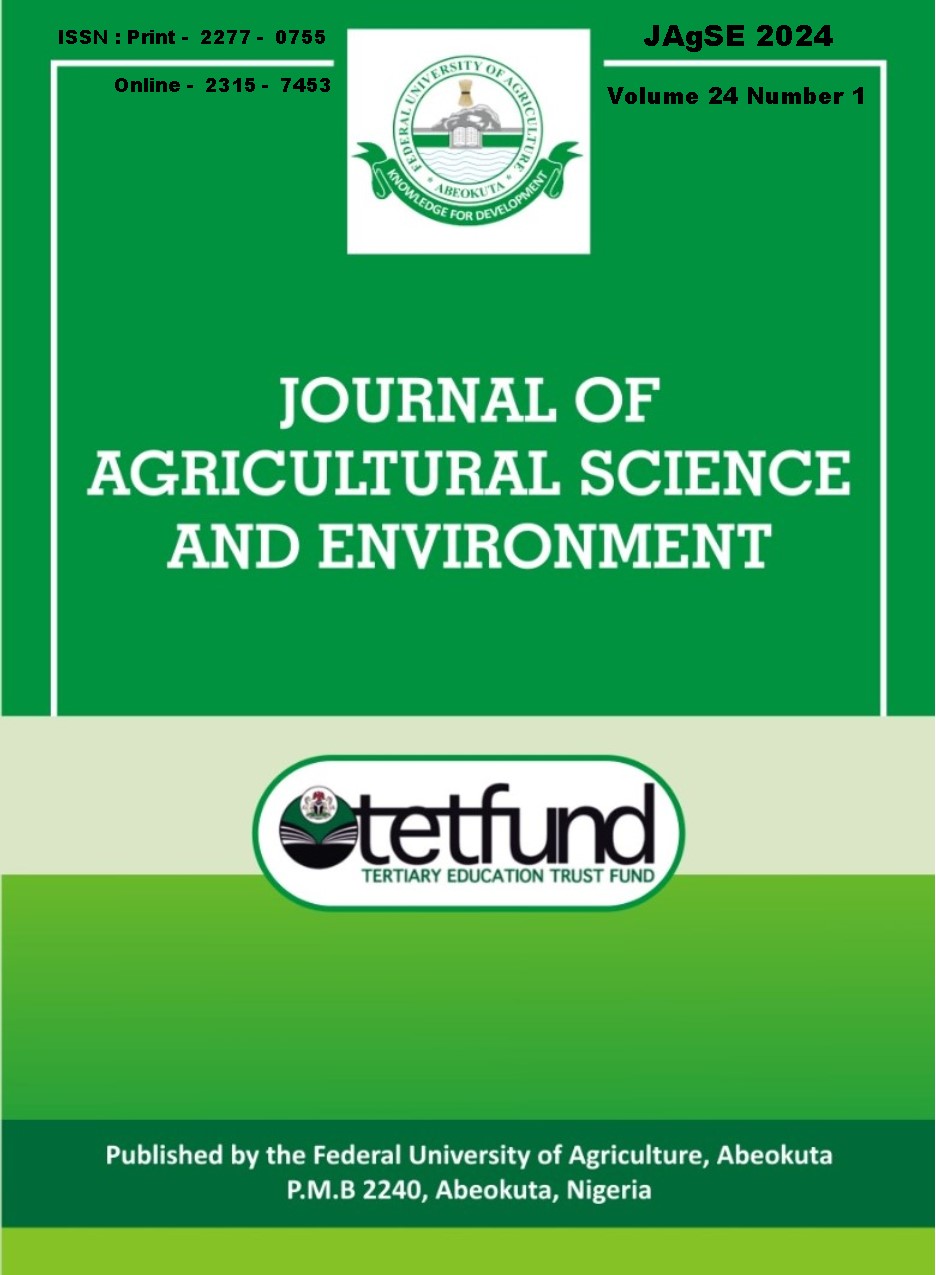IDENTIFICATION AND INTENSITY OF OCCURRENCE OF FUNGI ASSOCIATED WITH SPOILAGE OF TOMATO FRUITS IN SOME MAJOR MARKETS IN OGUN STATE NIGERIA
Keywords:
Deterioration, Fruits, Health, Fungi load, TomatoAbstract
Tomato (Lycopersicon esculentum Mill) fruit has high moisture content and very soft exocarp which predisposes it to mechanical damage and subsequent microbial infections that lead to spoilage. The condition is worsened with the postharvest and marketing/retail practices in the open markets; hence the experiments were carried out to isolate and identify the fungi causing deterioration of tomato fruits in major markets of selected Local Government Areas in Ogun State. Partially-deteriorated tomato fruits were collected from the markets for laboratory analysis using serial dilutions and pour plate method to isolate, identify and determine the frequency of occurrence of the fungi species present. Presence of Penicillium notatum, Aspergillus flavus, Alternaria spp and Fusarium oxysporum was established. Frequency of occurrence ranged between 17.14 and 65.71% while average fungi load count was 2.0 × 103. Occurrence was highest in metropolitan open daily market and least percentage in village weekly market.
References
Abdel-Mallek, A.Y. Hemida, S. K. and M. M.K Bagy 1995. Studies on fungi associated with tomato fruits and effectiveness of some commercial fungicides against three pathogens. Mycopathologia 130: 109 -116.
Aminu R.O., Ayinde I. A. and S. B. Ibrahim 2015.Technical Efficiency of maize production in Ogun State, Nigeria. Journal of Development and Agricultural Economics 7 (2):55-60 DOI: 10.5897/JDAE2014.0579 ISSN 2006-9774
Barkai-Golan, R. 2008. Aspergillus mycotoxins. In: Barkai-Golan, R. and Paster, N. (Eds.) Mycotoxins in fruits and vegetables. Elsevier, San Diego, CA, USA: pp 115-151.
Barkai-Golan, R. and Parker, N. (2008).Mouldy fruits and vegetables as a source of mycotoxins: part 1. World Mycotoxin Journal 1(2): 147-159
Beauchat, L. R. F., Copeland, M. S., Curiale, T., Danisavich, V., Gangar, B.W., King, T.W., Lawils, R.O., Likin, J., Okwusoa, C.F., Smith and D.E., Townsend. 1998. Comparison of the Simplate total plate count method with Petrifilm, Redigel and conventional pour plate method method for enumerating aerobic micro-organisms in foods. Journal of Food Protection. 61:14-18.
Chun-Ta, Wu. 2010. An overview of postharvest biology and technology of fruits and Vegetables. In: 2010 AARDO Workshop on technology on reducing postharvest losses and maintaining quality of fruits and vegetables. Pp. 2-11
Dogondaji, S.D., Baba, K.M., Muhammad, I., Magaji, M.D, 2005: Evaluation of onion storage losses and implication for food security in Sokoto Metropolis. Bulletin of Science Association of Nigeria.26: 10 – 14.
Idah, P. A., Ajisegiri, E. S. A., and Yisa, M. O. 2007. Fruits and vegetables handling and transportation in Nigeria. Australian Journal of Technology 10(3): 175 -183.
Ibrahim, A.D., K. Musa, A. Sani, A.A. Aliero, B.S. Yusuf. 2011 Microorganisms associated with the production of volatile compounds in spoilt tomatoes. Research in Biotechnology, 2 (2): 82-89.
Kader, A.A, Rolle RS 2004. In the role of post-harvest management in assuring the quality and safety of horticultural produce, FAO Food and Agricultural Organizations of the United Nations, Rome.
Kader, A.A. 2005 Increasing food availability by reducing postharvest losses of fresh produce. Acta Horticulture, 682: 2169-2175.
Kutama, A.S, Aliyu, BS and Mohammed, I (2007). Fungi pathogens associated with tomato wicker baskets. SWJ. 2, 38-39
Mohammed, S., Shehu, K. and Amusa, .A. 2004. Survey of the market diseases and aflatoxin Contamination of tomato Lycopersicon esculentum Mill) fruits in Sokoto, Northwestern Nigeria. Nutrition and Food Science 34(2): 72 – 76.
Obikwe, C.O., Obaseki-Ebor, E.E. 1987. Incidence of tomato fungi and their in-vitro
Inhibition by Honey Distillate (Hy-1).Nigerian Journal of Microbiology 7(1): 121-127
Onuorah, S., Orji, M.U. 2015. Fungi Associated with the Spoilage of Post-harvest Tomato Fruits Sold in Major Markets in Awka, Nigeria. Universal Journal of Microbiology Research 3(2): 11-16
Opadokun, J.S. 1987. Reduction of post-harvest losses in fruits and vegetables. Lectures delivered at AERLS/NSPRI Joint National Crop protection workshop, Institute for Agricultural Research, Zaria, Nigeria. Pp. 3-26.
Rodriquez P., Soares C.,Kozakiewicz, Z.,Paterson R.R.M., Lima, N., Venancio A. 2017. Identification and Characterization of Aspergillus flavus and toxins. Communicating Current Research and Educational topics and trends in Applied Microbiology 527-534.
Salau, I. A., Shehu K 2015. An overview of the fungi diseases of vegetables in Sokoto,
Nigeria, Global Advanced Research Journal of Agricultural Science. 4 (1):1-5
Sanyaolu, A. A. A. 2016 Postharvest fungi deterioration of tomato (Lycopersicum esculentum Mill) and pepper (Capsicum annumL): the “ESA” connection. Science World Journal 11 (3):1-10 www.scienceworldjournal.org ISSN 1597-6343
Smith, A. F. 1994. The tomatoes in America. University of Ilorin Press, Ilorin ISBN 0-252-07009-7
Ugwu, C. O., Chukwuezi, F.O., Ozougwu V. C.O. 2014. Microbial agents of tomato spoilage in Onitsha metropolis. Advances in Biological Research 8(2):87-93.
Zain, M.E. 2011: Impact of mycotoxins on humans and animals. Journal of Saudi Chemical
Society 15(2): 129-144.


